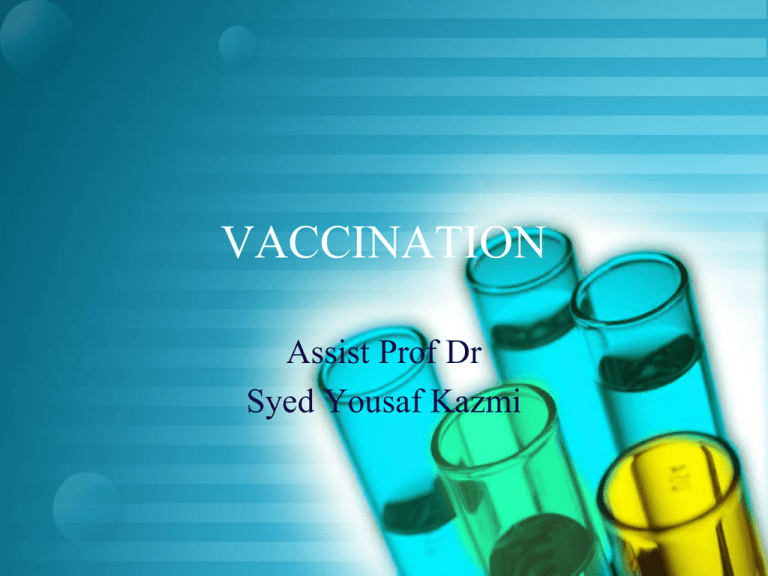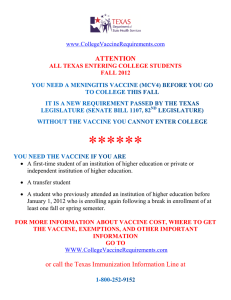Vaccination
advertisement

VACCINATION Assist Prof Dr Syed Yousaf Kazmi OBJECTIVES Explain active and passive immunity Define & explain basic concepts and mechanisms of protection Classify common vaccines List common vaccine preventable diseases Discuss immunization program ACTIVE IMMUNITY Active immunity is induced after contact with foreign antigens Clinical or subclinical infection, immunization, exposure to microbial products (e.g., toxins, toxoids), Host actively produces antibodies, lymphocytes- ability to respond to the antigens Adv: Long term protection Disadv: Slow onset Innate & adaptive immunity PASSIVE IMMUNITY Antibodies produced in another host Passive administration of antibody against certain viruses (e.g. Hepatitis B) -limit viral multiplication after needle prick Adv: Preformed antibodies is promptly available in large amounts Disadv: short life span of these antibodies and possible hypersensitivity to foreign Ig MECHANISMS OF PROTECTION Immunization is an Artificial Adaptive Response to an antigen May be Active or Passive In Active Artificial Response-Antigen used in the forms of Live Attenuated pathogen (bacterium, virus etc.), Killed whole cell, Microbial extract, Vaccine conjugate In Passive Artificial Response-Preformed immunoglobulins from other species are administered MECHANISM OF PROTECTIONACTIVE IMMUNIZATION Aim is to generate Primary Adaptive Immune response & Memory B/T cells Future exposure to a microorganism/ toxin etc. will elicit a secondary Adaptive Immune response due to Memory Cells A rapid and higher Antibody response is elicited Protection is achieved MECHANISM OF PROTECTIONACTIVE IMMUNIZATION CELLULAR RESPONSE IN IMMUNIZATION All intracellular microbes e.g. virus, Mycobacterium tuberculosis elicit Cellular Adaptive response (Cytotoxic T cells) Immunization by Live/ attenuated viruses-cell mediated response-Memory T cells Subsequent exposure to virus/ intracellular microbe-lysis of infected cell HUMORAL RESPONSE IN IMMUNIZATION Soluble antigens/ vaccine conjugates elicit Humoral response Secondary immune response is produced due to activation of memory B cells-antibody produced Neutralization of pathogen/ toxin etc. CLASSIFICATION OF VACCINES 1. LIVE VACCINES Attenuated living microbes Replicate in host-elicit immune response without causing disease More robust and long-lasting immune response with single dose Chance to revert to virulent form Require cold chain for survival Contraindicated in immunocompromised/ Pregnancy Polio, Rubella, Mumps, Typhoid fever Cell mediated immunity CLASSIFICATION OF VACCINES 2. INACTIVATED VACCINES Cannot replicate in host Safe in immunocompromised/ pregnancy Mount weak immune response Multiple doses (booster) for protection Mainly Humoral immunity Whole cell & Fractional vaccine INACTIVATED VACCINE A. Whole Cell Vaccine a. Bacteria (Pertussis, Typhoid, Cholera, Plague) b. Viruses (Polio, Hepatitis A, Rabies, Influenza) B. Fractional Vaccine a. Subunit Protein Based (Hepatitis B, acellular pertussis, Influenza, Anthrax) b. Toxoid (Diphtheria, Tetanus) c. Polysaccharide Vaccines a. Pure ( Salmonella Vi, Pneumococcal) b. Conjugate ( Hib, Pneumococcal) LIST OF COMMON VACCINE PREVENTABLE DISEASES Diphtheria, Haemophilus Influenzae serotype b, Hepatitis B, Measles, Meningitis, Mumps, Pertussis, Poliomyelitis, Rubella Tetanus, Tuberculosis, Yellow fever, Influenza, Pneumococcal pneumonia IMMUNIZATION PROGRAM THANK YOU ANY QUESTION


